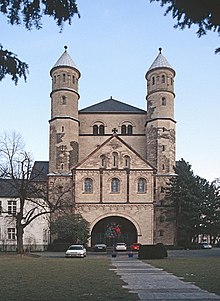Siegburg reform
The monastic reform movement of the Benedictine monks and also of some women's monasteries in the late 11th and early 12th centuries , which goes back to the Archbishop of Cologne in Anno II , is called Siegburg Reform .
Emergence

The reform is named after the Siegburg monastery . Anno II founded this in 1064. The first convent consisted of monks from the St. Maximin monastery in Trier . This was one of the centers of the Gorzer Reform in Germany. Anno later turned from this direction. Not least, secular reasons played a role here, since Anno was in dispute with Abbot Dietrich von St. Maximin over the Malmedy monastery .
From a trip to Italy in 1070, Anno brought several monks from the Fruttuaria monastery to Germany. This abbey was based on the model of Cluny , but was independent. The monastic orientation of Fruttuaria seemed forward-looking for Anno. He had chosen Siegburg as the model for the implementation.
Content
In terms of content, the Siegburg model was a mixed observation of Clunianzian elements conveyed via Fruttuaria, aspects of the Gorzer reform and special ideas from Annos. The Siegburg variant of the reform differed from the Cluny model in that none of the monasteries should have a priority. This changed at the latest in the time of Archbishop Friedrich I , when a closer union developed.
Even more important was that the monasteries of the Siegburg Observance were not directly subordinate to the Pope, but remained embedded in the diocesan association. This means that the " libertas coloniensis " Annos granted the brothers free elections to abbots and bailiffs, but the abbots were obliged to attend the respective diocesan synod and remained subordinate to the bishop. In addition, the elected abbot required confirmation from the bishop. Compared to the monastery reform of Gorze, which advocated that the abbots should perform service at the court of the princes or the bishops as sovereigns, this was not provided for in the Siegburg model. The reference to the bishop ensured that the secular monastery bailiffs could not exert any significant influence on the communities, but also meant that the monasteries could not pursue a policy that was independent of the bishop. Overall, the Siegburg direction can be characterized as an episcopal reform movement, although the abbots in Siegburg later got into a certain competition with the archbishops. An association formation like that operated by Cluny did not materialize.
development
When the previous monks in Siegburg refused to follow him, Anno sent them back to their home monastery without further ado. In a similar way, he enforced the new statutes in St. Pantaleon in Cologne, as Lampert von Hersfeld reported. After the previous monks had been expelled, violent uprisings broke out in Cologne. Although St. Pantaleon remained a monastery in the Siegburg sense, Anno's successors, for fear of further resistance, refrained from reforming the other Cologne monasteries in accordance with Anno.
Initially by the monks from Siegburg, the reform was further spread. Initially, the spread was limited to the Archdiocese of Cologne . Anno and his successors introduced them to Saalfeld , Brauweiler , Grafschaft , Gladbach , Deutz , Groß St. Martin in Cologne and Flechtdorf by 1120 . The Siegburg reform was also introduced in some monasteries in the suffragan dioceses of Minden , Münster , Osnabrück and Utrecht . Since 1126 it has also found its way into the diocese of Regensburg . Abbot Kuno von Siegburg established the monastery Nonnenwerth , located on an island in the Rhine, in 1110 as the first women's monastery in the spirit of the Reformation. A few women's convents were added later in Cologne and Gladbach.
Because of its structure geared towards the bishop and not towards the pope, the Siegburg direction did not take the position of Rome during the investiture dispute , but remained neutral overall. This clearly distinguished them from the Hirsau observance . Around 1170 the Siegburg Reformation lost its momentum, not least because it lost the support of the high clergy and the nobility. The fact that the new orders of the Cistercians (monastic reform) and Premonstratensian (reform canons) took the lead in the monastic reform movement contributed to this.
literature
- Wilfried Hartmann: The Investiture Controversy . Munich, 1990. p. 56
- Edeltraud Klueting: Monasteria Semper reformanda . Hamburg, 2005 Partial digitization
- Hans-Joachim Kracht: The foundation of the Grafschaft abbey by Archbishop Anno II of Cologne and the Siegburg reforms . In: Josef Wiegel (Ed.): Grafschaft. Contributions to the history of the monastery and the village. Grafschaft, 1972. pp. 53-64
- Josef Semmler: The monastery reform of Siegburg. Its expansion and reform program in the 11th and 12th centuries . (= Rheinisches Archiv , 53) Bonn, 1959.
- Erich Wisplinghoff : The Benedictine Abbey Siegburg . Berlin, 1975 p. 21ff.
